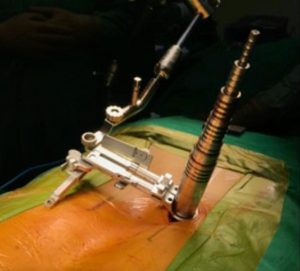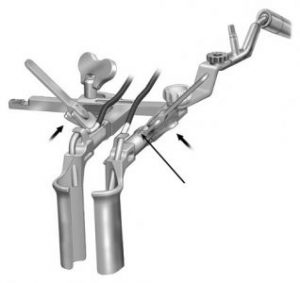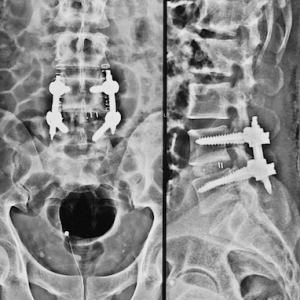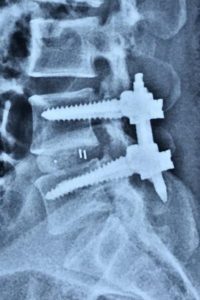Minimally Invasive Spine Surgery
Key Hole Spine Surgeries
Minimally Invasive Spine Surgeries (MIS Spine Surgery) or key-hole spine surgeries are spine surgery procedures done with minimal soft tissue destruction. The main aims of the surgery, i.e. decompression, instrumentation and fusion are achieved with a small skin incision. Specialized retractor system are used for decompression surgeries. Specialized equipment are used for MIS spine surgery to allow instrumentation through tiny holes in the skin. A microscope/ endoscope is usually used for these surgeries.
Advantages of Minimally Invasive Spine Surgery:
- Safe and precise surgery due to better magnification and illumination of the surgical field.
- Less soft-tissue and muscle damage.
- Cosmetic scar due to small skin incision/s.
- Minimal blood loss during the surgery.
- Less chances of infection.
- Minimal post-operative pain
- Less requirement for pain medicines.
- Faster mobilization and rehabilitation.
- Short hospital stay.
- Early return to work.
Disadvantages/ Limitation of Minimally Invasive Spine Surgery:
- Requires special expertise to perform,
- Requires specialized OT setup and surgical assistance,
- Requires specialized instruments, microscope, endoscope etc.,
- May not be suitable for certain pathologies, e.g. severe spinal stenosis, high grade spondylolisthesis etc.
- Not suitable for multilevel pathologies.
Types of Minimally Invasive Spine Surgeries:
Most commonly done minimally invasive spine surgeries are microdiscectomy, MIS TLIF and anterior cervical discectomy & fusion. However, almost all types of spine surgeries can be performed by minimally invasive spine surgery techniques.
- Anterior cervical spine decompression and fusion surgeries (ACDF/ ACCF),
- Posterior cervical spine decompression and fusion surgeries,
- Posterior cervical micro-foraminotomy,
- Anterior thoracic spine surgeries,
- Posterior thoracic spine decompression and instrumentation surgeries,
- Anterior lumbar decompression and fusion surgeries (ALIF/ XLIF/ OLIF),
- Posterior lumbar decompression and fusion surgeries (MIS TLIF),
- Sacro-iliac fusion surgeries,
- Kyphoplasty/ Vertebroplasty.
Not all surgeries can be treated by a minimally invasive spine surgery procedure. However, principles of MIS spine surgery can be applied to traditional surgeries also as much as possible. In fact, recovery pattern for most of the traditional spine surgeries is not much different when compared to MIS surgeries. This is due to advanced surgical techniques and equipment. It is very important to choose correct procedure which will give maximum benefit with minimal side effect for a particular pathology.
MIS Skin Incision


MIS Retractor


MIS Instrumentation


When it comes to spinal procedures, two primary approaches are commonly used: minimally invasive spine surgery (MISS) and open spine surgery. Each has its own set of advantages and disadvantages, and the choice between them depends on individual patient needs and the nature of the spinal condition.
Minimally Invasive Spine Surgery (MISS)
Advantages of Minimally Invasive Spine Surgery:
Smaller Incisions: One of the defining features of MISS is the use of small incisions, typically less than an inch in size. This results in less disruption to surrounding tissues and reduced scarring.
Minimal Muscle Damage: MISS techniques are designed to minimize muscle and tissue damage, which can lead to a quicker recovery and less postoperative pain.
Faster Recovery: Patients undergoing MISS often experience a faster recovery time compared to open surgery. They may spend less time in the hospital and return to daily activities sooner.
Reduced Blood Loss: Smaller incisions and less invasive techniques typically result in reduced blood loss during surgery.
Lower Risk of Infection: The smaller incisions and reduced exposure to the external environment can lower the risk of surgical site infections.
Disadvantages of Minimally Invasive Spine Surgery:
Limited Visibility: Because of the smaller incisions, the surgeon’s field of vision may be limited, which can be challenging for certain complex spinal procedures.
Not Suitable for All Cases: MISS may not be appropriate for all spinal conditions. Some cases may require the greater visibility and access provided by open surgery.
Open Spine Surgery
Advantages of Open Spine Surgery:
Comprehensive Access: Open surgery allows the surgeon a broader view of the surgical site, making it suitable for complex spinal procedures or cases that require extensive correction.
Direct Manipulation: Surgeons have direct access to the spine, allowing for precise correction and instrumentation placement.
Versatility: Open surgery can be adapted to various spinal conditions and anatomical complexities.
Disadvantages of Open Spine Surgery:
Larger Incisions: Open surgery typically involves larger incisions, which can result in more significant tissue disruption and longer healing times.
Increased Blood Loss: Due to the larger incisions and greater tissue exposure, open surgery may involve more blood loss during the procedure.
Extended Recovery: Patients may experience a longer hospital stay and a more extended recovery period after open surgery.
Greater Risk of Infection: The larger incisions increase the risk of surgical site infections.
Choosing the Right Approach
The choice between minimally invasive spine surgery and open spine surgery depends on various factors, including the specific spinal condition, the patient’s overall health, and the surgeon’s expertise. Both approaches have their place in spinal care, and the goal is to select the one that offers the best outcome for each individual case.
As a leading spine surgeon in Mumbai, I specialize in both minimally invasive and open spine surgery techniques. I work closely with my patients to determine the most suitable approach, ensuring the highest level of care and optimal results.
If you have questions or would like to discuss your spinal condition and treatment options, please don’t hesitate to contact me for a consultation +91-9967600461
In the realm of spine surgery, two advanced techniques have revolutionized the field: Minimally Invasive Spine Surgery (MISS) and Endoscopic Spine Surgery. These approaches have distinct characteristics, each offering unique advantages and disadvantages tailored to specific patient needs and conditions.
Minimally Invasive Spine Surgery (MISS)
Advantages of Minimally Invasive Spine Surgery:
Small Incisions: MISS is characterized by small incisions, usually less than an inch in size, resulting in minimal tissue damage and less postoperative scarring.
Reduced Pain: Patients undergoing MISS often experience less postoperative pain and discomfort, contributing to a quicker recovery.
Faster Recovery: Smaller incisions and less tissue disruption lead to shorter hospital stays and a quicker return to daily activities.
Lower Infection Risk: The reduced exposure of tissues to the external environment lowers the risk of surgical site infections.
Less Blood Loss: Smaller incisions typically result in reduced blood loss during surgery.
Disadvantages of Minimally Invasive Spine Surgery:
Limited Visibility: Due to smaller incisions, surgeons may have a limited field of vision, which can be challenging for certain complex spinal procedures.
Not Suitable for All Cases: MISS may not be the ideal choice for all spinal conditions, especially those requiring extensive correction or for cases that necessitate greater visibility.
Endoscopic Spine Surgery
Advantages of Endoscopic Spine Surgery:
Minimally Invasive: Like MISS, endoscopic spine surgery involves small incisions, minimizing tissue disruption and scarring.
Enhanced Visibility: Endoscopic techniques use specialized instruments with cameras, providing excellent visualization of the surgical site.
Precise Targeting: Surgeons can precisely target and treat specific spinal issues with the help of real-time imaging.
Faster Recovery: Reduced tissue damage and small incisions contribute to faster postoperative recovery.
Disadvantages of Endoscopic Spine Surgery:
Learning Curve: Endoscopic procedures may require a steeper learning curve for surgeons, as they involve specialized equipment and techniques.
Limited Versatility: Endoscopic surgery may not be suitable for all spinal conditions, particularly complex or multifocal issues.
Instrumentation Constraints: The use of endoscopic instruments may limit the range of motion and maneuverability compared to traditional open surgery.
Choosing the Right Approach
The choice between Minimally Invasive Spine Surgery (MISS) and Endoscopic Spine Surgery depends on several factors, including the specific spinal condition, the patient’s overall health, and the surgeon’s expertise. Both approaches represent significant advancements in spinal care, and the goal is to select the one that best aligns with the patient’s unique needs.
As a leading spine surgeon in Mumbai, I specialize in both Minimally Invasive Spine Surgery and Endoscopic Spine Surgery techniques. I work closely with my patients to determine the most suitable approach, ensuring the highest level of care and optimal results.
If you have questions or would like to discuss your spinal condition and treatment options, please don’t hesitate to contact me for a consultation at +91-9967600461
When it comes to spinal surgery, one common concern that patients often have is the cost. Many wonder whether minimally invasive spine surgery (MISS) is significantly more expensive than routine open surgery and whether the benefits outweigh the investment. Let’s shed some light on this matter.
Cost of Minimally Invasive Spine Surgery
It’s true that the initial cost of minimally invasive spine surgery can be marginally higher than that of routine open surgery. This difference primarily stems from the specialized instruments, advanced technology, and increased surgical precision required for MISS. Additionally, the learning curve for surgeons who perform minimally invasive procedures may also impact costs.
The Value of Minimally Invasive Spine Surgery
While there may be a slightly higher price tag associated with minimally invasive spine surgery, it’s essential to consider the substantial advantages it offers:
1. Reduced Hospital Stay: MISS often results in shorter hospital stays compared to open surgery, which can translate into lower overall healthcare costs.
2. Quicker Recovery: Patients undergoing MISS typically experience faster recovery times and can return to their daily activities sooner. This may reduce indirect costs associated with extended recovery periods, such as time off work.
3. Less Postoperative Pain: Minimally invasive techniques are designed to minimize tissue damage, leading to less postoperative pain. This, in turn, may reduce the need for pain management medications.
4. Smaller Incisions and Scarring: Smaller incisions mean less scarring, which can be a significant benefit both aesthetically and for the patient’s comfort.
5. Reduced Risk of Infection: The smaller incisions and reduced exposure to external pathogens may lower the risk of surgical site infections.
6. Precision and Minimized Complications: MISS offers enhanced precision and visualization, potentially reducing the risk of surgical complications and the need for additional procedures.
The Bottom Line
While the cost of minimally invasive spine surgery may be marginally higher than that of routine open surgery, it’s important to view this investment as a long-term benefit for your health and well-being. The advantages provided by MISS, including quicker recovery, reduced pain, and minimized complications, can lead to an improved quality of life.
Ultimately, the choice between minimally invasive and open surgery should be based on your specific medical condition, surgeon’s recommendations, and your personal preferences. It’s essential to have an open and informed discussion with your healthcare provider to determine the most suitable approach for your individual needs.
As a leading spine surgeon in Mumbai, I specialize in both minimally invasive and open spine surgery techniques. I am committed to providing the highest level of care and helping you achieve the best possible outcome while considering your unique circumstances.
If you have questions or would like to discuss your spinal condition and treatment options, please don’t hesitate to contact me for a consultation at +91-9967600461

Are you doing Endoscopic fusion awake surgery
No. I do not believe in that technology. I don’t think it is a technique which will ensure fusion.